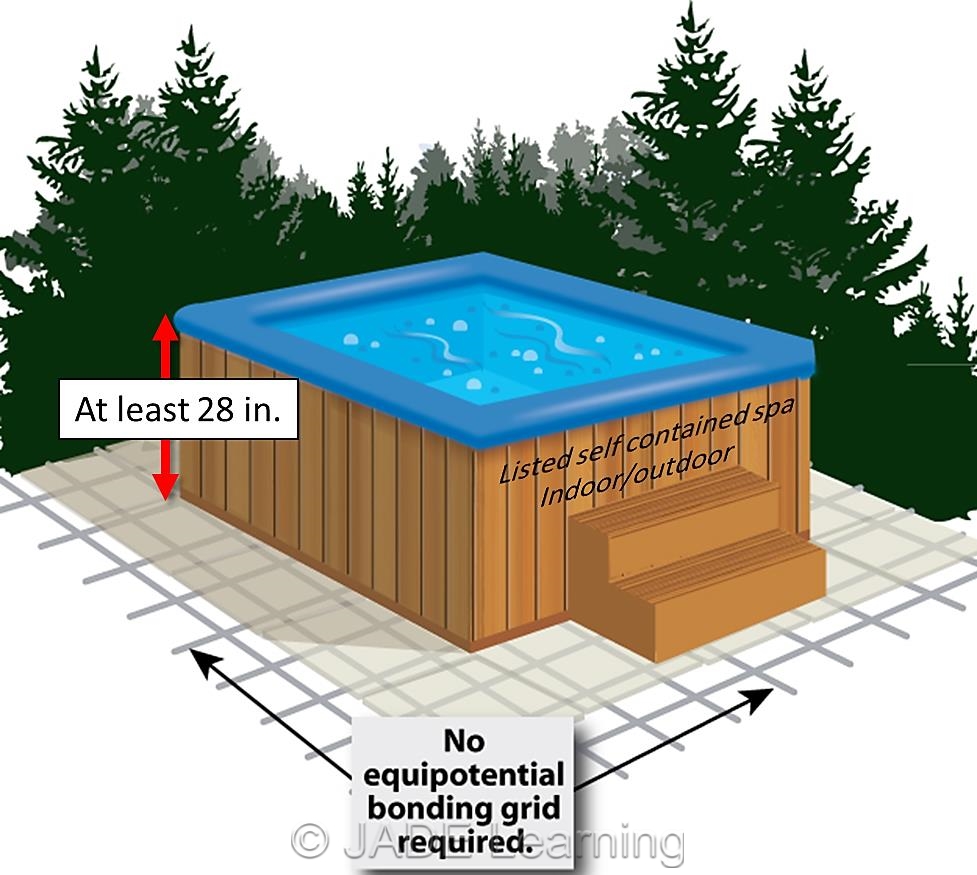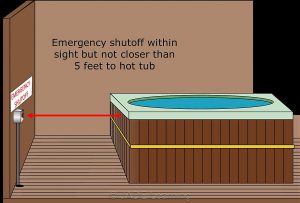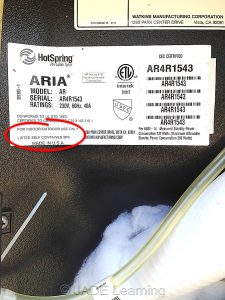Pool and Spa Wiring Part II

By: JADE Instructor | Aug 26, 2015
Last month we discussed common electrical items that cause swimming pool inspections to fail. As we get closer to fall, many people will be installing hot tubs to enjoy a warm retreat from the cool weather. Most spas and hot tubs, other than those that qualify as a “storable hot tub”, are covered in Part IV of Article 680. Here is a list of the most common electrical mistakes made when installing a hot tub outdoors.
1. Missing or improperly located emergency shutoff switch.
Section 680.41 requires an emergency shutoff switch for all occupancies other than single family dwellings. The switch must be located within sight of but no closer than 5 feet to the hot tub. It also must be clearly labeled as to its purpose. In a single family dwelling, an emergency shutoff is not required.

2. Equipotential bonding grid for perimeter surfaces missing or incorrectly installed.

Section 680.42 specifies that outdoor hot tubs also have to comply with Part II of Article 680 which includes the bonding of perimeter surfaces. Equipotential bonding of the perimeter surfaces is not required if the installation meets the following conditions in 680.42(B) 1-4:
- The spa or hot tub shall be listed as a self-contained spa for aboveground use.
- The spa or hot tub shall not be identified as suitable only for indoor use.
- The installation shall be in accordance with the manufacturer’s instructions and shall be located on or above grade.
- The top rim of the spa or hot tub shall be at least 28 in. above all surfaces around the hot tub that are within 30 in., measured horizontally from the spa or hot tub. The height of nonconductive external steps for entry to or exit from the self-contained spa shall not be used to reduce or increase this rim height measurement
A spa or hot tub must be listed by one of the third party testing agencies like UL, Met Labs, or ETL and meet all of the conditions in 680.42(B) if an equipotential bonding grid is not installed. There are many manufacturers of spas and hot tubs that fail to have their product listed by a nationally recognized testing laboratory. The unlisted units are cheaper but do not comply with this section of the NEC. Be sure to check the label to make sure it is a listed unit.
No equipotential bonding grid required.
3. Missing GFCI protection for hard wired hot tub outlets.
GFCI protection required for outdoor self-contained hot tub outlets.
Section 680.44 requires ground-fault circuit interrupter protection for the hot tub “outlet”. A receptacle is always considered an outlet, but an outlet can be something other than a receptacle. Article 100 defines an “outlet” as a point on the wiring system where power is taken to supply the equipment. This includes both hard wired installations and cord-and-plug connected units. 50 and 60 amp GFCI protected disconnecting switches are commercially available at stocked at most supply houses as well as large big box hardware stores.
If you are in need of electrical continuing education, please visit our website at https://www.jadelearning.com


Jeff – 110.26(C) entrance to and egress from working space – if the panel is in a pool equipment room and there is a 30″ wide by 36″ (type 2 wall situation) deep x 6′ high clearance but the pipes are obstructing access to the panel from the access door to the panel, should I move the panel and only maintain GFCI breaker disconnecting devices for the pump motors, and heat pumps? Do I need a 30×36 inch space in front of the disconnects?
Going just by 110.26(C), the location of the pool panelboard is okay. Because the panelboard is not large equipment, there is no requirement for the minimum size opening. If getting to the panelboard requires crawling through a 2-foot by 2-foot opening, it would not be a violation of 110.26(C). Having said that, in accordance with 240.24(A), overcurrent devices shall be readily accessible. Readily accessible (as defined in Article 100) means capable of being reached quickly for operation, renewal, or inspections without requiring those to whom ready access is requisite to actions such as to use tools, to climb over or remove obstacles, or to resort to portable ladders, and so forth. As long as getting to the panelboard can be accomplished by not climbing over the pipes, there is no violation. The definition of readily accessible does not say anything about stepping over or even crawling under obstacles.
If the panelboard is moved and a motor disconnecting means is installed, I personally would want working space [in accordance with 110.26(A)] in front of the GFCI disconnecting means. Because the GFCI disconnecting means is an overcurrent device, the same readily accessible rule applies to it. Instead of a GFCI disconnecting means, a non-fused disconnecting means could be installed. With a non-fused disconnecting means, it could be argued it will not likely required examination, adjustment, servicing, or maintenance while energized. Therefore, no 110.26(A) working space would be required.
Charles R. Miller of Lighthouse Educational Services provided this response.
Does each conductor need to solid color insullation the whole lenght of conductor#6. .
Yes. For grounded conductors see section 200.6. For equipment grounding conductors see 250.119. For identification of ungrounded conductors see 210.5(C). If there is only one voltage system, such as 240/120 volts, in the premise, then identification of ungrounded conductors is not required. If there is more than one voltage system present in the building then each ungrounded conductor of a branch circuit must be identified by phase or line or system at all termination, connection, and splice points. The identification means must be posted at each branch-circuit panelboard location.
Thank you for posting, great information and easy to understand. I work in commercial electrical work in Phoenix.
I just bought a Thermospa Atlantis 200 spa. It calls for 40amps at 240V and the manual indicates 6/4 wire (cable). Can I use 6/3 wire with Ground?
What about water bonding? I see the exception regarding the bonding of perimeter surfaces, but I don’t see the water bonding requirement going away